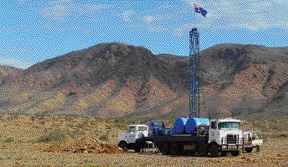Perth, Australia — The Australian stock market has kept its bullish stance, despite an upcoming political event that could punch a big hole in exploration confidence and cause the country’s anti-uranium “No New Mines” policy to be retained.
That event is the federal convention of the Australian Labor Party (ALP) in April, where one of the divisive issues discussed will be whether to end the party’s anti-uranium policy, which has hobbled Australia’s uranium production for the past three decades.
The federal Liberal coalition government of Australian Prime Minister John Howard has made it clear it wants to see Australia not only open up new mines to export uranium, but also look at nuclear power as a future option. He has also signed trade pacts with the Chinese, who are keen to buy Australian uranium.
Howard is now a veteran, having first been elected prime minister in 1996, and intends to contest the next federal election in about two years. His new opponent, ALP leader Kevin Rudd, like previous ALP leader Kim Beazley, has said he wants the ALP No New Mines policy revoked.
The problem for the ALP is that while many unionists and members of the centre and right want to see development of the country’s known, rich uranium endowment, the anti-uranium cell in the party’s left is set to fight to retain the existing policy. The faction draws support from recent media polls showing that while exporting more uranium is now better accepted, the concept of domestic nuclear power is not.
The Australian Stock Exchange is accepting as many as one new uranium exploration listing every week, and Patersons Securities Josh Welch says that by March, the number could swell to as many as 110 uranium prospectors, compared with two miners and a handful of explorers two years ago.
Rudd is gaining in popularity and his party is marginally ahead of the coalition in recent polls, but Premier Alan Carpenter of Western Australia — one of the three states in which uranium figures — has said he won’t be issuing any mining licences for uranium, even if the April convention upends the policy.
South Australia already hosts BHP Billiton’s (BHP-N, BHP-A) massive Olympic Dam copper-uranium mine; mining leases have also already been issued for Toronto-listed SXR Uranium One’s (SXR-T, SXRFF-O) Honeymoon project.
Queensland Labor says it would support Rudd, if the No New Mines policy is overturned.
Then there is the Northern Territory (NT), where Chief Minister Clare Martin is anti-uranium, but has had to accept the territory’s limited control over export licences.
While it isn’t clear which party will govern Australia after the next federal election, all the states are ALP-governed and the Liberals have been thumped in all recent state elections and appear to lack messiahs to bring their respective parties out of the wilderness.
When the political limitations were put on uranium exports by both governing parties as much as three decades ago, Australia was considered to have about 26% of world uranium resources as well as some of the most economic deposits.
The prospecting renaissance has seen most of the mothballed discoveries revisited and at least one major new find — Four Mile by in situ uranium miner Heathgate Resources (a subsidiary of General Atomics of the United States), near its Beverley mine.
This is a roll-front deposit where grades are reportedly as high as Energy Resources of Australia’s (EGRAF-O, ERA-A) Ranger mine in the Northern Territory. A new study by Dundee Securities says Australia (through its three mines) supplied 23% of global uranium production in 2005 and contains 36% of the lowest-cost global uranium resources.
Welch, aware that Australia’s new wave of explorers are largely inexperienced, says some of the smarter operators are those that have partnered or merged with more seasoned companies, including two initiatives by Canadian Mega Uranium (mga-t, mgaff-o), which has picked up South Australia’s Hindmarsh Resources and Redport Ltd.
Summit Resources (SRCSF-O, SMM-A), which moved into Queensland several years ago and holds old discoveries that it has expanded, believes lifting restrictions on uranium exports from Australia would give it the scope to become the fourth-biggest global producer.
Summit has looked in its first six years to produce export revenue of A$4 billion ($3.66 billion) for a surplus of A$2.3 billion ($2.1 billion). This prefeasibility blueprint would see the Queensland project milling 4.5 million tonnes per year at a head grade of 2.5 lbs. per tonne to produce 7.6 million lbs. of U308 — based on a uranium price of US$60 per lb. and a vanadium price (byproduct) of US$7 per lb.
The Australian stock market has a strong nerve and perhaps its uranium project promoters will turn out to be right on a change in policy — but if they are wrong, then Canada would be one of the beneficiaries.
— Based in Perth, Australia, the author is a freelance writer specializing in mining.


Be the first to comment on "Aussie uranium explorers ride political wild horse"